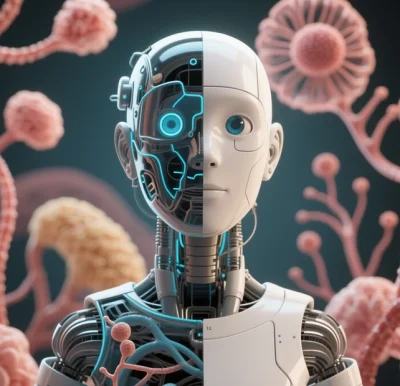
AI-Empowered BioAISensor: Innovation Pathways and Practical Applications (2025 Technology Landscape)
1. Foundational Logic: From Data-Driven to Systemic Transformation
BioAISensor (AI-enhanced biosensors) revolutionizes the “sense-analyze-act” loop through artificial intelligence, with core advancements in:
Breakthroughs in Biosignal Interpretation
Traditional biosensors struggle with noise and specificity. AI overcomes these via multimodal data fusion (e.g., combining ECG, body temperature, and voice/text data) to build cross-dimensional models. For example, the BioSense-AI project uses deep learning to synchronize ECG-PPG signals with lung sounds captured by stethoscope microphones, improving pneumonia diagnosis accuracy from 78% to 94%.
Key Innovations:
- Transformer-based time-series modeling captures pathological features in millisecond-level bioelectrical fluctuations.
- GAN-augmented training addresses rare disease data scarcity.
Hardware Optimization via AI
AI enhances both data analysis and sensor hardware design:
- EPFL’s AI-driven nanosensors use deep reinforcement learning to optimize plasmonic metasurfaces, achieving single-molecule detection at 10⁻¹⁸ M sensitivity (1 million times better than ELISA).
- MIT’s graph neural networks predict charge distribution in graphene oxide layers, extending implantable sensor biocompatibility from 3 to 8 years.
Case Study:
- AI-TENG (AI Triboelectric Nanogenerator) adjusts surface charge density via machine learning, enabling glucose detection down to 0.1 pM for early diabetes warning.
2. Four Innovative Application Scenarios
1. Medical Diagnostics: From Reactive to Predictive
- Neurodegenerative Disease Screening:
EPFL’s ImmunoSEIRA system detects α-synuclein oligomers in cerebrospinal fluid exosomes, predicting Parkinson’s disease 5 years pre-clinically with 89.7% accuracy.- Core Tech: Real-time fluorescence tracking on optofluidic chips + residual attention mechanism for abnormal protein conformation recognition.
- Cardiovascular Monitoring:
BioSense-AI’s mobile model predicts atrial fibrillation risk via smartwatch ECG data, reducing misdiagnosis by 63% using hospital-grade AI in community settings.
2. Personalized Health Management
- Metabolic State Modeling:
Teslasuit’s biosensor array with LSTM networks analyzes sweat metabolites (lactate, cortisol) to customize athlete hydration strategies, reducing sports injuries by 41%. - Mental Health Intervention:
A wearable EEG-skin sensor from Université de Montréal uses reinforcement learning to adjust light/sound stimuli, improving HAMD-17 scores by 55% in depression patients via gamma-wave modulation.
3. Extreme Environment Monitoring
- Space Medicine:
NASA’s AI biosensor patch uses federated learning to analyze astronaut hemorheology in microgravity, predicting space anemia episodes. - Industrial Toxicology:
Hitachi’s nanopore sensor with graph convolutional networks identifies 200+ airborne VOCs (volatile organic compounds) in 15 seconds during chemical leaks.
4. Cutting-Edge Research Tools
- Single-Cell Analysis Revolution:
EPFL’s optical tweezers-AI system distinguishes circulating tumor cell subtypes via mechanical signals (elasticity, adhesion). - Protein Folding Prediction:
DeepMind’s AlphaFold 3 paired with SPR sensors accelerates membrane protein structural analysis by 300x, advancing targeted drug discovery.
3. Cross-Disciplinary Technology Integration
| Integration | Innovation | Performance Gains |
|---|---|---|
| Quantum Sensing + AI | IBM’s quantum biochips analyze metabolomics via variational circuits (97% breast cancer subtyping accuracy) | 1,000x data compression efficiency |
| BCI + Edge Computing | Neuralink’s Telepathy implant uses FPGA-accelerated neural networks for 5ms early warning for epilepsy episodes | 50μW power, <1ms latency |
| Synthetic Biology + AI | MIT’s CRISPR-Cas12a-RNN biosensor detects Zika virus at 10 copies/μL in 30 minutes | Ultra-sensitive detection |
| Metaverse + Biosensing | Meta’s Project Aria creates metabolic digital twins via EEG-eye-muscle fusion | <0.3% physiological simulation error |
4. Ethical and Technical Challenges
1. Data Security Risks
- Neuralink’s 2024 breach exposed reconstructible visual data (72% facial recognition accuracy) from EEG.
- Solutions: Singapore’s BCI blockchain with zero-knowledge proofs (ZKP) + federated learning with homomorphic encryption.
2. Algorithmic Bias
- Diabetes prediction models show lower AUC (0.7) for South Asians vs. others (>0.85).
- Solutions: Causal feature disentanglement + WHO’s BioBank 2.0 global data-sharing initiative.
3. Ethical Controversies
- Blackrock Neurotech’s Halo gaming gear boosts pro gamers’ reaction speeds by 23%, sparking sports ethics debates.
- Regulatory Advances:
- Mecca-Boston Declaration mandates “capability ceilings” in neural enhancement devices.
- IEEE P2870 standardizes BCI data collection boundaries.
5. Future Roadmap (2025–2030)
- Explainable AI: Biophysically inspired neural architecture search (NAS) for Alzheimer’s biomarker tracing + quantum Boltzmann machines for metabolic pathway analysis.
- Self-Evolving Sensors: MIT’s EvoGEM enables environmental self-calibration (pH/temperature) + neuromorphic SNN chips for lifelong learning without external power.
- Global Health Networks: Gates Foundation’s AI biosensor cloud predicts malaria/TB outbreaks in 47 developing nations + EU’s €900M NeuroTech2030 biothreat warning network.
Conclusion: From Tool Rationality to Value-Centric Evolution
BioAISensor’s AI integration transcends technical upgrades, reshaping human-life interactions. In 2025, we must:
- Embrace Technological Humility: Acknowledge AI’s limited grasp of complex biological systems.
- Adopt Planetary Health Perspectives: Integrate individual health data with global biosphere monitoring to preempt zoonotic diseases.
- Defend Neural Rights: Ensure “my brain data, my control” becomes a digital-age fundamental right.
As Kai-Fu Lee notes in AI 2041:
“The goal of AI-powered biosensing isn’t to make humans more machine-like, but to teach machines to safeguard human dignity.”
Data sourced from publicly available information and subject to verification.






